Lymphatic Tissue Transfer: Ultrasound-Guided Description and Preoperative Planning of Vascularised Lymph Nodes, Lymphatic Units, and Lymphatic Vessels Transfers †
Abstract
:1. Introduction
2. Patients and Methods
2.1. Vascularised Lymph Node Transfer
2.2. Vascularised Lymph Nodes and Afferent Lymphatic Vessels Transfer
2.3. Vascularised Lymphatic Vessels Transfer
3. Outcome Analysis
4. Results
5. Discussion
6. Conclusions
Author Contributions
Funding
Institutional Review Board Statement
Informed Consent Statement
Data Availability Statement
Conflicts of Interest
References
- Jeffe, H.I.; Richter, M.N. The regeneration of autoplastic lymph node transplants. J. Exp. Med. Ann. Surg. 1928, 47, 977–980. [Google Scholar] [CrossRef] [PubMed] [Green Version]
- Clodius, L.; Smith, P.J.; Bruna, J.; Serafin, D. The lymphatics of the groin flap. Ann. Plast. Surg. 1982, 9, 447–458. [Google Scholar] [CrossRef] [PubMed]
- Schaverien, M.V.; Badash, I.; Patel, K.M.; Selber, J.C.; Cheng, M.H. Vascularized lymph node transfer for lymphedema. Semin. Plast. Surg. 2018, 32, 28–35. [Google Scholar] [CrossRef] [PubMed]
- Viitanen, T.P.; Visuri, M.T.; Hartiala, P.; Mäki, M.T.; Seppänen, M.P.; Suominen, E.A.; Saaristo, A.M. Lymphatic vessel function and lymphatic growth factor secretion after microvascular lymph node transfer in lymphedema patients. Plast. Recontr. Surg. Glob. Open 2013, 1, 1–9. [Google Scholar] [CrossRef]
- Ito, R.; Suami, H. Overview if lymph node transfer for lymphedema treatment. Plast. Reconstr. Surg. 2014, 134, 548–556. [Google Scholar] [CrossRef]
- Lin, C.H.; Ali, R.; Chen, S.C.; Wallace, C.; Chang, Y.C.; Chen, H.C.; Cheng, M.H. Vacularized groin lymph node transfer using the wrist as a recipient site for management of postmastectomy upper extremity lymphedema. Plast. Recontr. Surg. 2009, 123, 1265–1275. [Google Scholar] [CrossRef] [Green Version]
- Cheng, M.H.; Huang, J.J.; Nguyen, D.H.; Saint-Cyr, M.; Zenn, M.R.; Tan, B.K.; Lee, C.L. A novel approach to the treatment of lower extremity lymphedema by transferring a vascularized submental lymph node flap to the ankle. Gynecol. Oncol. 2012, 126, 93–98. [Google Scholar] [CrossRef]
- Cheng, M.H.; Chen, S.C.; Henry, S.L.; Tan, B.K.; Lin, M.C.Y.; Huang, J.J. Vascularized groin lymph node flap transfer for postmastectomy upper limb lymphedema: Flap anatomy, recipient sites, and outcomes. Plast. Recontr. Surg. 2013, 131, 1286–1298. [Google Scholar] [CrossRef]
- Suami, H.; Koelmeyer, L.; Mackie, H.; Boyages, J. Patterns of lymphatic drainage after axillary node dissection impact arm lymphoedema severity. A review of animal and clinical imaging studies. Surg. Oncol. 2018, 27, 743–750. [Google Scholar] [CrossRef]
- Yamamoto, T.; Iida, T.; Yoshimatsu, H.; Fuse, Y.; Hayashi, A.; Yamamoto, N. Lymph flow restoration after tissue replantation and transfer: Importance of lymph axiality and possibility of lymph flow reconstruction without lymph node transfer or lymphatic anastomosis. Plast. Reconstr. Surg. 2018, 142, 796–804. [Google Scholar] [CrossRef]
- Yoshimatsu, H.; Visconti, G.; Karakawa, R.; Hayashi, A. Lymphatic system transfer for lymphedema treatment: Transferring the lymph nodes with their lymphatic vessels. Plast. Reconstr. Surg. Glob. Open. 2020, 8, e2721. [Google Scholar] [CrossRef] [PubMed]
- Yamamoto, T.; Yamamoto, N.; Kageyama, T.; Sakai, H.; Fuse, Y.; Tsukuura, R. Lymph-interpositional-flap transfer (LIFT) based on lymph-axiality concept: Simultaneous soft tissue and lymphatic reconstruction without lymph node transfer of lymphatic anastomosis. J. Plast. Reconstr. Aesthet. Surg. 2021, 74, 2604–2612. [Google Scholar] [CrossRef] [PubMed]
- Visconti, G.; Tartaglione, G.; Bartoletti, R.; Salgarello, M. Compartimental harvesting of dual lymph node flap from the right supraclavicular area for the treatment of lower extremity lymphedema: A case series. J. Plast. Reconstr. Aesthet. Surg. 2019, 72, 211–215. [Google Scholar] [CrossRef] [PubMed]
- Chen, W.F.; McNurlen, M.; Ding, J.; Bowen, M. Vascularized Lymph Vessel Transfer for Extremity Lymphedema—Is Transfer of Lymph Node Still Necessary? Int. Microsurg. J. 2019, 3, 1. [Google Scholar] [CrossRef]
- Visconti, G.; Bianchi, A.; Hayashi, A.; Cina, A.; Maccauro, G.; Almadori, G.; Salgarello, M. Thin and super thin perforator flaps elevation based on preoperative planning with ultrahigh-frequency ultrasound. Arch. Plast. Surg. 2020, 47, 365–370. [Google Scholar]
- Yamamoto, T.; Yamamoto, N.; Hara, H.; Mihara, M.; Narushima, M.; Koshima, I. Upper extremity lymphedema index: A simple method for severity evaluation of upper extremity lymphedema. Ann. Plast. Surg. 2013, 70, 47–49. [Google Scholar] [CrossRef]
- Yamamoto, T.; Matsuda, N.; Todokoro, T.; Yoshimatsu, H.; Narushima, M.; Mihara, M.; Uchida, G.; Koshima, I. Lower extremity lymphedema index: A simple method for severity evaluation of lower extremity lymphedema. Ann. Plast. Surg. 2011, 67, 637–640. [Google Scholar] [CrossRef]
- Hayashi, A.; Visconti, G. Supermicrosurgical Lymphaticovenular Anastomosis: A Practical Textbook; HV Projects; Lulu Press: Morrisville, NC, USA, 2020. [Google Scholar]
- Scaglioni, M.F.; Arvanitakis, M.; Chen, Y.C.; Giovanoli, P.; Chia-Shen Yang, J.; Chang, E.I. Comprehensive review of vascularized lymph node transfers for lymphedema: Outcomes and complications. Microsurgery 2018, 38, 222–229. [Google Scholar] [CrossRef]
- Visconti, G.; Hayashi, A.; Bianchi, A.; Salgarello, M. Technological advances in Lymphatic Surgery: The emerging role of Ultrasound. Plast. Reconstr. Surg. 2019, 144, 940e–942e. [Google Scholar] [CrossRef] [Green Version]
- Visconti, G.; Yamamoto, T.; Hayashi, N.; Hayashi, A. Ultrasound-assisted lymphaticovenular anastomosis for the treatment of peripheral lymphedema. Plast. Reconstr. Surg. 2017, 139, 1380e–1381e. [Google Scholar] [CrossRef]
- Hayashi, A.; Giacalone, G.; Yamamoto, T.; Belva, F.; Visconti, G.; Hayashi, N.; Handa, M.; Yoshimatsu, H.; Salgarello, M. Ultra High-frequency Ultrasonographic Imaging with 70 MHz Scanner for Visualization of the Lymphatic Vessels. Plast. Reconstr. Surg. Glob. Open. 2019, 7, e2086. [Google Scholar] [CrossRef] [PubMed]
- Singhal, D.; Tran, B.N.; Angelo, J.P.; Lee, B.T.; Lin, S.J. Technological advances in lymphatic surgery: Bringing to light the invisible. Plast. Reconstr. Surg. 2019, 144, 734–741. [Google Scholar] [CrossRef] [PubMed]
- Bianchi, A.; Visconti, G.; Hayashi, A.; Santoro, A.; Longo, V.; Salgarello, M. Ultra-High frequency ultrasound imaging of lymphatic channels correlates with their histological features: A step forward in lymphatic surgery. J. Plast. Reconstr. Aesthet. Surg. 2020, 73, 1622–1629. [Google Scholar] [CrossRef] [PubMed]
- Scaglioni, M.F.; Suami, H. Lymphatic anatomy of the inguinal region in aid of vascularized lymph node flap harvesting. J. Plast. Reconstr. Aesthet. Surg. 2015, 68, 419–427. [Google Scholar] [CrossRef]
- Chang, E.I.; Chu, C.K.; Hanson, S.E.; Selber, J.C.; Hanasono, M.M.; Schaverien, M.V. Comprehensive Overview of Available Donor Sites for Vascularized Lymph Node Transfer. Plast. Reconstr. Surg. Glob. Open 2020, 8, e2675. [Google Scholar] [CrossRef]
- Visconti, G.; Bianchi, A.; Hayashi, A.; Salgarello, M. Pure skin perforator flap direct elevation above the subdermal plane using preoperative ultra-high frequency ultrasound planning: A proof of concept. J. Plast. Reconstr. Aesthet. Surg. 2019, 72, 1700–1738. [Google Scholar] [CrossRef]
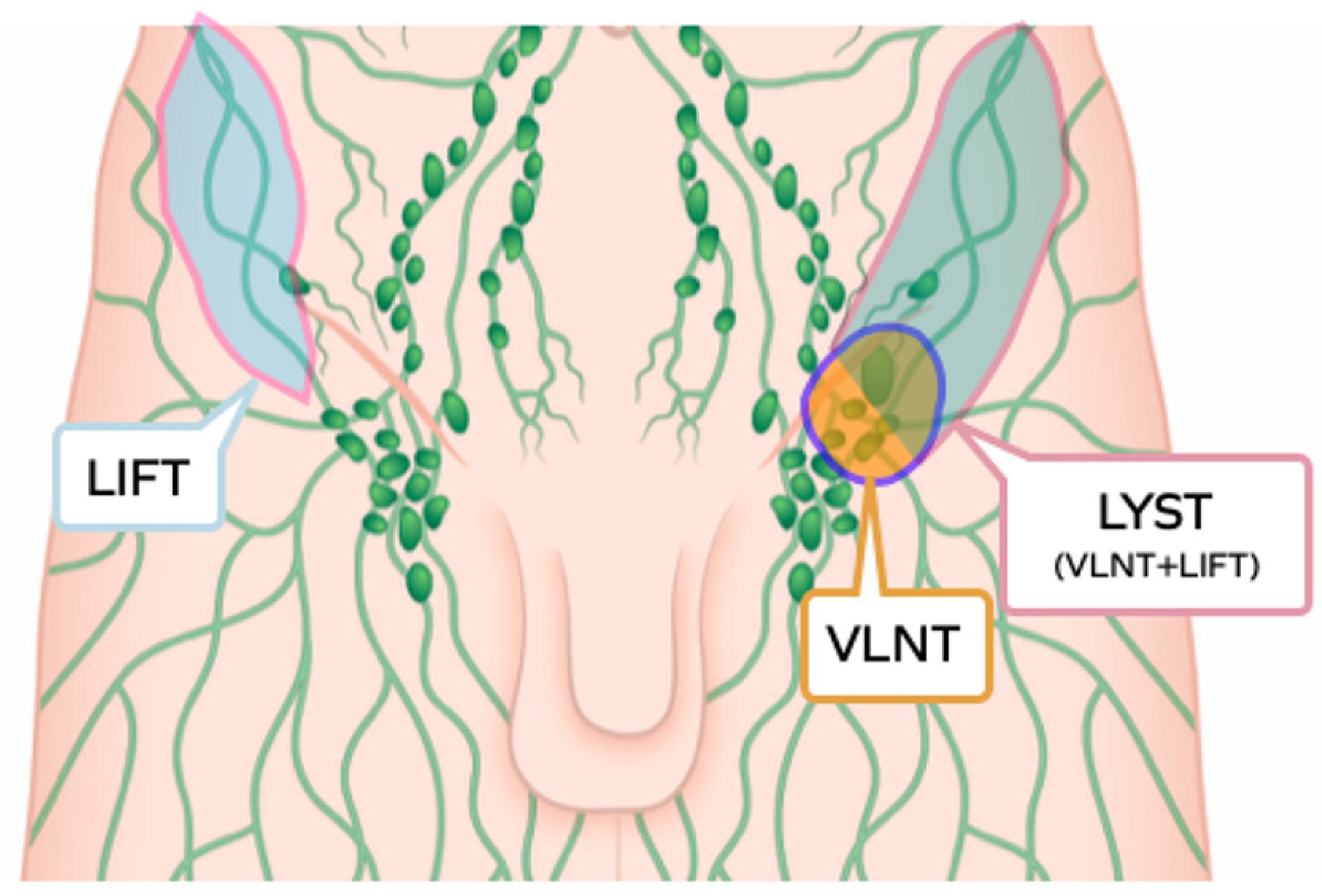
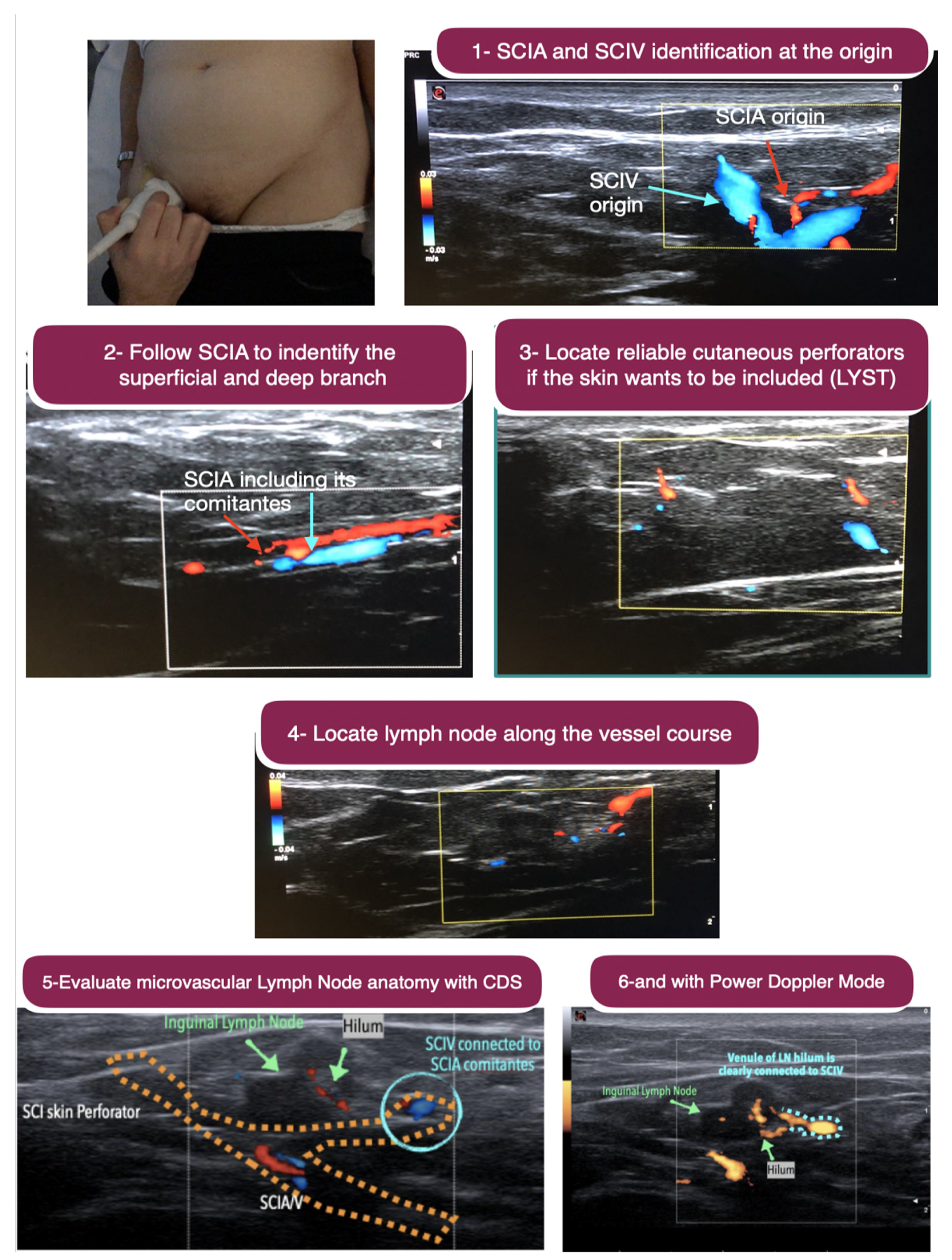

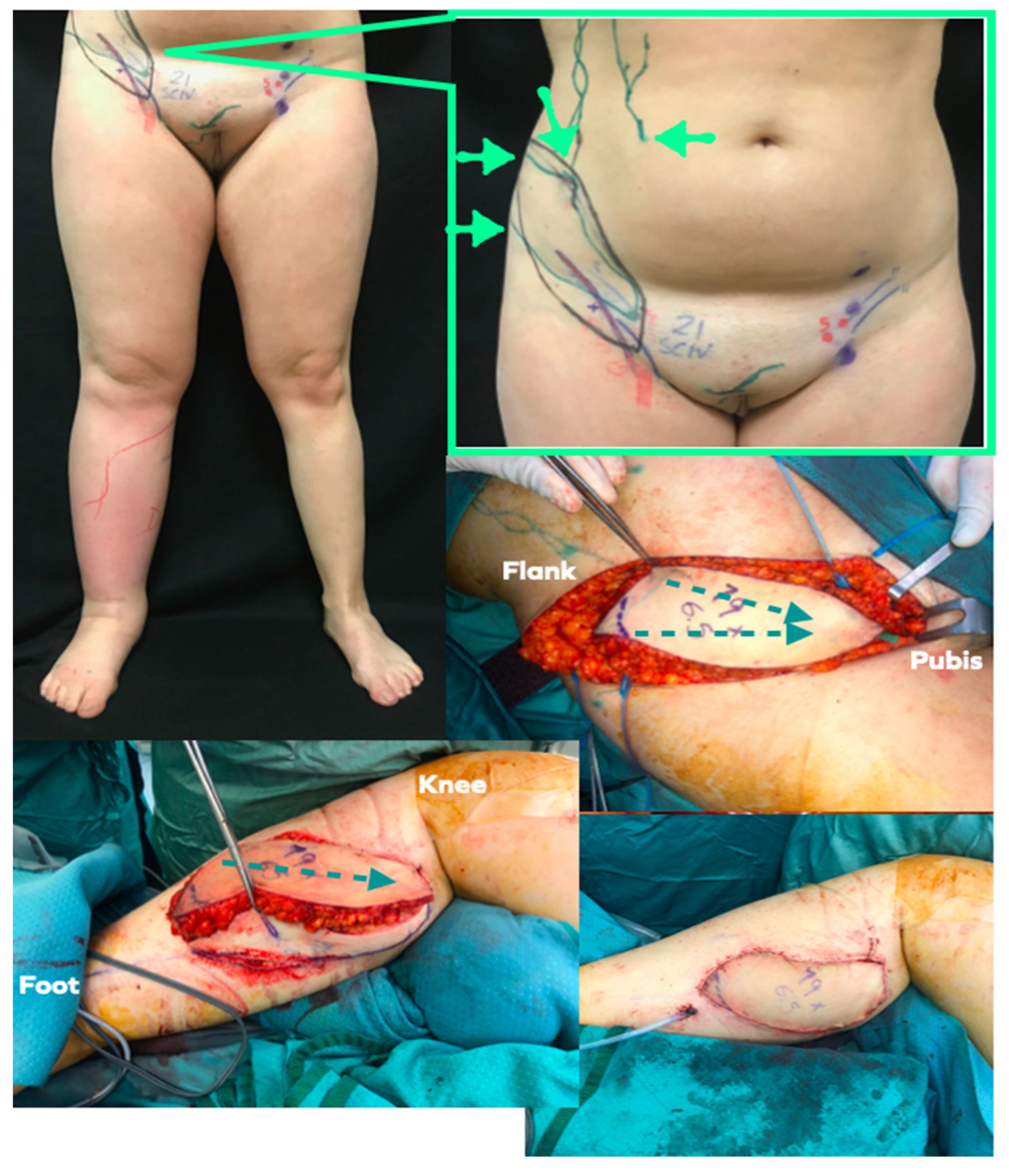
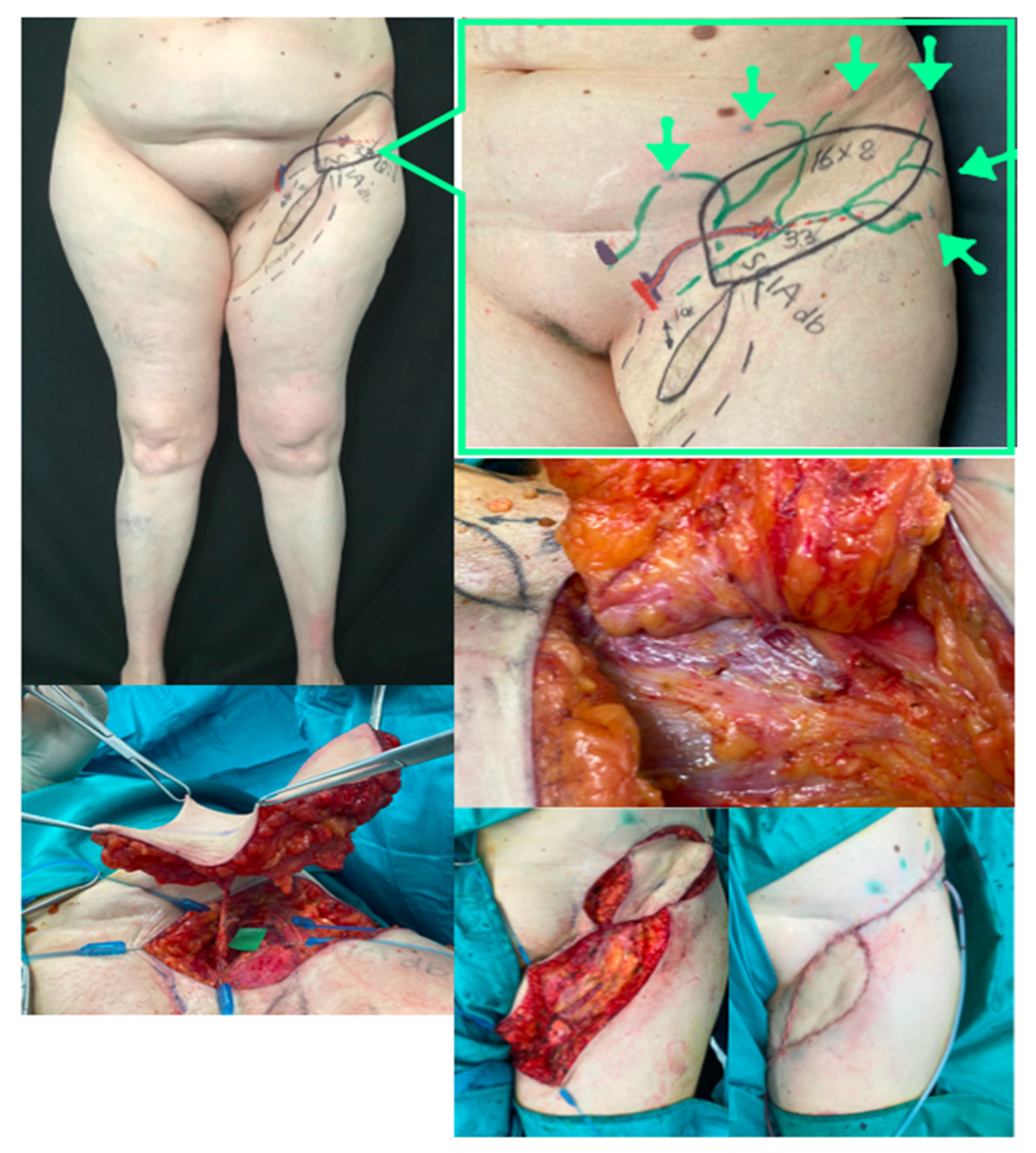
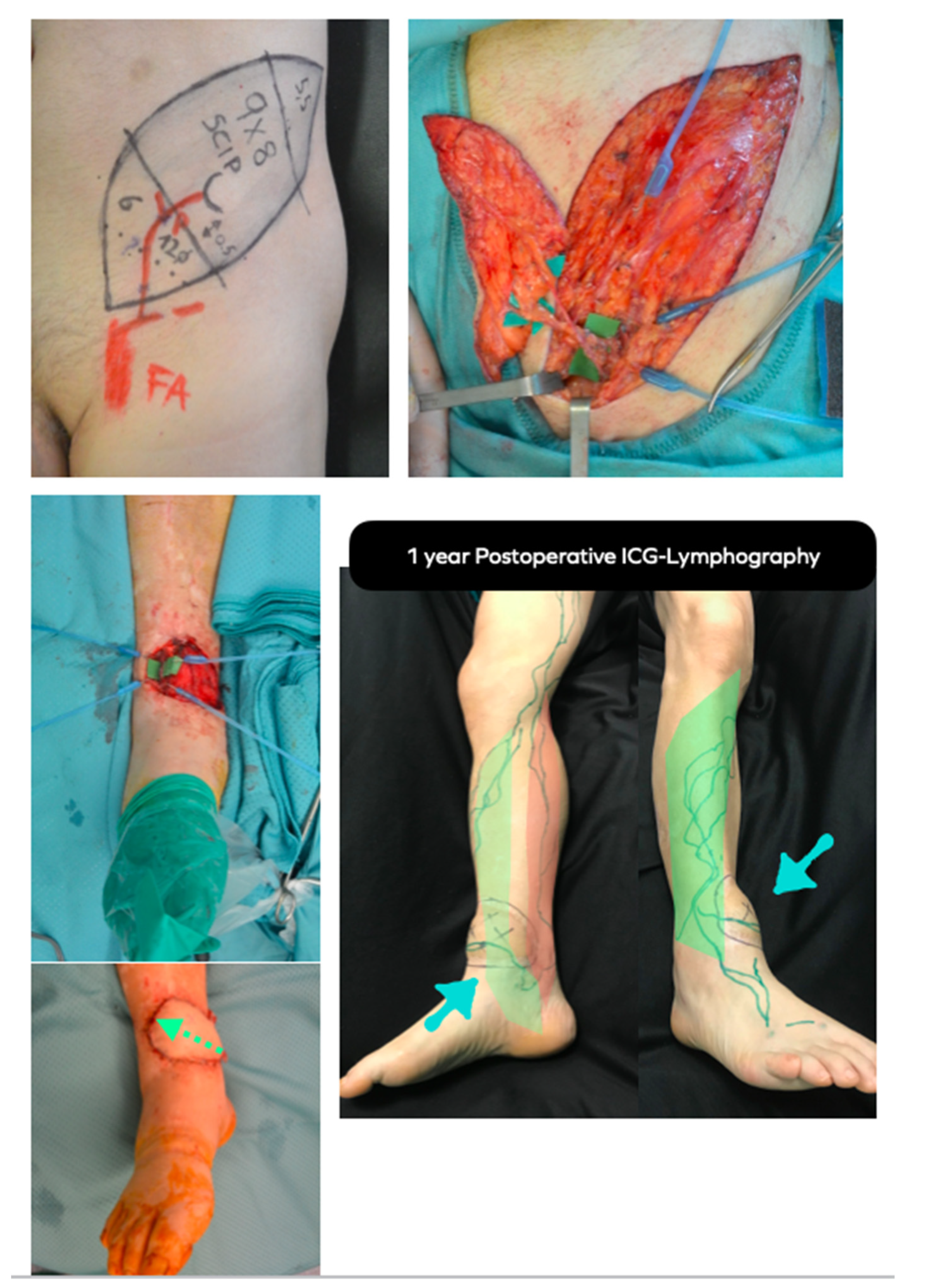
| Overall No. of Patients | 45 |
| Age, years | |
| Mean ± SD | 54.6 ± 12.1 |
| Range | 23–72 |
| Sex | |
| Male, n (%) | 12 (27%) |
| Female n (%) | 33 (73%) |
| BMI, kg/m2 body surface | |
| Mean ± SD | 27.3 ± 3.1 |
| Range | 18.5 –31.4 |
| Cancer-related lymphedema n (%) | 26 (58%) |
| Upper extremity lymphedema n (%) | 11 (42%) |
| Lower extremity lymphedema n (%) | 15 (58%) |
| Prostate cancer n (%) | 4 (27%) |
| Endometrial cancer n (%) | 8 (53%) |
| Melanoma n (%) | 3 (20%) |
| Radiation Therapy n (%) | 23 (77%) |
| Primary lower extremities lymphedema n (%) | 4 (8%) |
| Preoperative ISL stage | |
| 2b n (%) | 22 (73%) |
| 3 n (%) | 8 (27%) |
| Trauma—Lower extremity soft tissue defect | 15 (34%) |
| Defect location | |
| Proximal third of leg n (%) | 5 (33%) |
| Middle third of leg n (%) | 4 (27%) |
| Distal third of leg n (%) | 5 (33%) |
| Foot | 1 (7%) |
| Comorbidities in trauma patients | |
| Diabetes Mellitus n (%) | 1 (7%) |
| Hypertension n (%) | 5 (33%) |
| Active Smoking n (%) | 0 |
| Peripheral vascular disease n (%) | 1 (7%) |
| Characteristic | VLNT | LYST | LIFT | |||
|---|---|---|---|---|---|---|
| Inguinal | Supraclavicular | Lateral Thoracic | Inguinal | Free SCIP | Pedicled SCIP | |
| Overall no. of flaps | 6 with DIEP 5 apart | 13 | 3 | 7 | 7 | 4 |
| Flap size | ||||||
| mean± SD, cm | 8.5 × 5.8 ± 2.1 × 1.3 | 7.2 × 3.5 ± 1.8 × 0.9 | 18.1 × 6.8 ± 3.5 × 1.5 | 15 × 5.5 ± 2 × 1.8 | 16.2 × 6.3 ± 3.5 × 2.5 | |
| Flap thickness mean, range, mm | ||||||
| Full thickness 25, 20–29 | / | / | / | 7 | / | 4 |
| Thin flap 16.4 9–28 | / | / | / | / | 3 | 0 |
| Superthin flap 5.5 4–7 | / | / | / | / | 4 | 0 |
| Recipient site | ||||||
| Orthotopic | 11, axilla | 0 | 3 | 4, axilla | / | 4, inguinal scar |
| Eterotpic | 0 | 13, leg | 0 | 1, wrist 3, leg | / | 0 |
| Complications | 0 | 0 | 0 | 0 | 0 | 0 |
| UEL index reduction mean ± SD | 8.1 ± 4.5 | / | 5.6 ± 3.5 | 18.3 | / | / |
| LEL index reduction mean ± SD | / | 13.4 ± 8.3 | / | 23.3 ± 8.5 | / | 16.8 ± 6.8 |
| Limb softness | +++ | ++ | ++ | + | + | +++ |
| Outcome | Analysis | Significance | |
|---|---|---|---|
| Upper Limb Lymphedema index postoperative reduction | Comparison of ULL index pre and postoperative at 1 year follow-up | Pre: 195.8 ± 45.9 Post: 188.3 ± 39.4 Δ: 7.2 ± 5.7 | p = 0.17 paired t-test |
| Lower Limb Lymphedema index postoperative reduction | Comparison of LLL index pre and postoperative at 1 year follow-up | Pre: 345.4 ± 53.7 Post: 324.5 ± 58.6 Δ: 20.7 ± 7.1 | p = 0.18 paired t-test |
| Improved stability of results after physical therapy | Association between flap type (VLNT vs LYST-LIFT) and improved stability after physical therapy | VLNT: 3/21 LYST-LIFT: 9/24 | p = 0.10 Fisher’s exact test |
| Reduction of compression class | Association between flap type (VLNT vs LYST-LIFT) and reduction of compression class | VLNT: 0/21 LYST-LIFT: 1/24 | p = 0.99 Fisher’s exact test |
| Improvement of subjective symptoms perception | Association between the scar release performed with the flap and improvement of symptoms | Release +: 15/21 Release −: 4/9 | p = 0.22 Fisher’s exact test |
Publisher’s Note: MDPI stays neutral with regard to jurisdictional claims in published maps and institutional affiliations. |
© 2022 by the authors. Licensee MDPI, Basel, Switzerland. This article is an open access article distributed under the terms and conditions of the Creative Commons Attribution (CC BY) license (https://creativecommons.org/licenses/by/4.0/).
Share and Cite
Visconti, G.; Bianchi, A.; Salgarello, M.; Di Leone, A.; Hayashi, A.; Masetti, R.; Franceschini, G. Lymphatic Tissue Transfer: Ultrasound-Guided Description and Preoperative Planning of Vascularised Lymph Nodes, Lymphatic Units, and Lymphatic Vessels Transfers. J. Pers. Med. 2022, 12, 1346. https://doi.org/10.3390/jpm12081346
Visconti G, Bianchi A, Salgarello M, Di Leone A, Hayashi A, Masetti R, Franceschini G. Lymphatic Tissue Transfer: Ultrasound-Guided Description and Preoperative Planning of Vascularised Lymph Nodes, Lymphatic Units, and Lymphatic Vessels Transfers. Journal of Personalized Medicine. 2022; 12(8):1346. https://doi.org/10.3390/jpm12081346
Chicago/Turabian StyleVisconti, Giuseppe, Alessandro Bianchi, Marzia Salgarello, Alba Di Leone, Akitatsu Hayashi, Riccardo Masetti, and Gianluca Franceschini. 2022. "Lymphatic Tissue Transfer: Ultrasound-Guided Description and Preoperative Planning of Vascularised Lymph Nodes, Lymphatic Units, and Lymphatic Vessels Transfers" Journal of Personalized Medicine 12, no. 8: 1346. https://doi.org/10.3390/jpm12081346
APA StyleVisconti, G., Bianchi, A., Salgarello, M., Di Leone, A., Hayashi, A., Masetti, R., & Franceschini, G. (2022). Lymphatic Tissue Transfer: Ultrasound-Guided Description and Preoperative Planning of Vascularised Lymph Nodes, Lymphatic Units, and Lymphatic Vessels Transfers. Journal of Personalized Medicine, 12(8), 1346. https://doi.org/10.3390/jpm12081346









